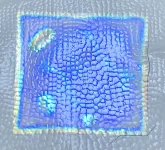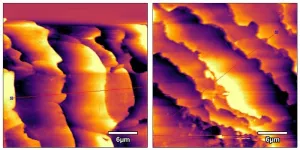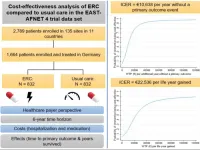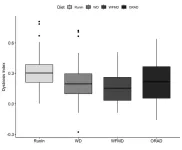(Press-News.org) INDIANAPOLIS, March 26, 2023 — In chemistry, we have He, Fe and Ca — but what about do, re and mi? Hauntingly beautiful melodies aren’t the first things that come to mind when looking at the periodic table of the elements. However, using a technique called data sonification, a recent college graduate has converted the visible light given off by the elements into audio, creating unique, complex sounds for each one. Today, the researcher reports the first step toward an interactive, musical periodic table.
The researcher will present his results at the spring meeting of the American Chemical Society (ACS). ACS Spring 2023 is a hybrid meeting being held virtually and in-person March 26–30, and features more than 10,000 presentations on a wide range of science topics.
A video on the research is available at www.acs.org/elementmusic.
Previously, W. Walker Smith, the project’s sole investigator, took his combined passions of music and chemistry and converted the natural vibrations of molecules into a musical composition. “Then I saw visual representations of the discrete wavelengths of light released by the elements, such as scandium,” says Smith. “They were gorgeous and complex, and I thought, ‘Wow, I really want to turn these into music, too.’”
Elements emit visible light when they are energized. This light is made up of multiple individual wavelengths, or particular colors, with brightness levels that are unique for each element. But on paper, the collections of wavelengths for different elements are hard to tell apart visually, especially for the transition metals, which can have thousands of individual colors, says Smith. Converting the light into sound frequencies could be another way for people to detect the differences between elements.
However, creating sounds for the elements on the periodic table has been done before. For instance, other scientists have assigned the brightest wavelengths to single notes played by the keys on a traditional piano. But this approach reduced the rich variety of wavelengths released by some elements into just a few sounds, explains Smith, who is currently a researcher at Indiana University.
To retain as much of the complexity and nuance of the element spectra as possible, Smith consulted faculty mentors at Indiana University, including David Clemmer, Ph.D., a professor in the chemistry department, and Chi Wang, D.M.A., a professor in the Jacobs School of Music. With their assistance, Smith built a computer code for real-time audio that converted each element’s light data into mixtures of notes. The discrete color wavelengths became individual sine waves whose frequency corresponded to that of the light, and their amplitude matched the brightness of the light.
Early in the research process, Clemmer and Smith discussed the pattern similarities between light and sound vibrations. For instance, within the colors of visible light, violet has almost double the frequency of red, and in music, one doubling of frequency corresponds to an octave. Therefore, visible light can be thought of as an “octave of light.” But this octave of light is at a much higher frequency than the audible range. So, Smith scaled the sine waves’ frequencies down by approximately 10-12, fitting the audio output into a range where human ears are most sensitive to differences in pitch.
Because some elements had hundreds or thousands of frequencies, the code allowed these notes to be generated in real time, forming harmonies and beating patterns as they mixed together. “The result is that the simpler elements, such as hydrogen and helium, sound vaguely like musical chords, but the rest have a more complex collection of sounds,” says Smith. For example, calcium sounds like bells chiming together with a rhythm resulting from how the frequencies interact with each other. Listening to the notes from some other elements reminded Smith of a spooky background noise, similar to music used in cheesy horror movies. He was especially surprised by the element zinc, which despite having a large number of colors, sounded like "an angelic choir singing a major chord with vibrato.”
“Some of the notes sound out of tune, but Smith has kept true to that in this translation of the elements into music,” says Clemmer. These off-key tones — known musically as microtones — come from frequencies that are found between the keys of a traditional piano. Agreeing, Wang says, “The decisions as to what’s vital to preserve when doing data sonification are both challenging and rewarding. And Smith did a great job making such decisions from a musical standpoint.”
The next step is to turn this technology into a new musical instrument with an exhibit at the WonderLab Museum of Science, Health, and Technology in Bloomington, Indiana. “I want to create an interactive, real-time musical periodic table, which allows both children and adults to select an element and see a display of its visible light spectrum and hear it at the same time,” says Smith. He adds that this sound-based approach has potential value as an alternative teaching method in chemistry classrooms, because it’s inclusive to people with visual impairments and different learning styles.
On Tuesday, March 28, at 3:00 p.m., during the ACS Spring 2023 Meeting, Smith will also perform “The Sound of Molecules,” a show that will feature audio clips of a few of the elements, as well as “compositions” of larger molecules.
Smith acknowledges support and funding from Indiana University’s Department of Chemistry, Center for Electronic and Computer Music, and Center for Rural Engagement; an Indiana University Undergraduate Research grant; the 2022 Annual Project Jumpstart Innovation Competition; and the Indiana University Hutton Honors College Grant Program.
A recorded media briefing on this topic will be posted Monday, March 27, by 10 a.m. Eastern time at www.acs.org/acsspring2023briefings. Reporters can request access to media briefings during the embargo period by contacting newsroom@acs.org.
For health and safety information for ACS Spring 2023, please visit the FAQ webpage.
The American Chemical Society (ACS) is a nonprofit organization chartered by the U.S. Congress. ACS’ mission is to advance the broader chemistry enterprise and its practitioners for the benefit of Earth and all its people. The Society is a global leader in promoting excellence in science education and providing access to chemistry-related information and research through its multiple research solutions, peer-reviewed journals, scientific conferences, eBooks and weekly news periodical Chemical & Engineering News. ACS journals are among the most cited, most trusted and most read within the scientific literature; however, ACS itself does not conduct chemical research. As a leader in scientific information solutions, its CAS division partners with global innovators to accelerate breakthroughs by curating, connecting and analyzing the world’s scientific knowledge. ACS’ main offices are in Washington, D.C., and Columbus, Ohio.
To automatically receive news releases from the American Chemical Society, contact newsroom@acs.org.
Note to journalists: Please report that this research was presented at a meeting of the American Chemical Society.
Follow us: Twitter | Facebook | LinkedIn | Instagram
Title
Designing an interactive musical periodic table: sonification of visible element emission spectra
Abstract
What does the element helium sound like? What about hydrogen? While these may seem like absurd questions, the process of data sonification can be used to convert the visible spectra of chemical elements into sounds. When stimulated by electricity or heat, elements release distinct wavelengths of light depending on their electron energy levels—a sort of “chemical footprint” unique to every element. These frequencies of light, which we perceive as different colors, can be scaled into the audio range to yield different sonic frequencies, allowing one to hear the different sounds of chemical elements. This research project involved the construction of an interactive musical periodic table, combining musical and visual representations of elemental spectra from high-resolution spectral datasets.
The interactive periodic table was designed using Max/MSP, a programming language that uses digital signal processing (DSP) algorithms to generate real-time audio and visual outputs. This allows all spectral lines of an element to be played simultaneously (as a “chord”) or for individual lines to be played in succession (as a “melody”). This highly interdisciplinary project has applications spanning data analysis, STEAM (STEM + Arts) education, and public science outreach. Sonification of scientific data provides alternative methods of analysis that can expand access of such data to blind and visually impaired people. Sonification can even enhance data analysis via traditional data visualization by providing a supplementary layer of auditory information, and sonification-based learning models have been shown to improve student engagement and understanding of scientific concepts like protein folding.
This program is currently being implemented in several middle and high school music and science classes, as well as a public music/science show titled “The Sound of Molecules” at WonderLab Museum of Science. Future work will focus on designing a free and open-source version of the program that does not require specialized DSP software.
END
What do the elements sound like? (video)
2023-03-26
ELSE PRESS RELEASES FROM THIS DATE:
Colorful films could help buildings, cars keep their cool
2023-03-26
INDIANAPOLIS, March 26, 2023 — The cold blast of an air conditioner can be a welcome relief as temperatures soar, but “A/C” units require large amounts of energy and can leak potent greenhouse gases. Today, scientists report an eco-friendly alternative — a plant-based film that gets cooler when exposed to sunlight and comes in a variety of textures and bright, iridescent colors. The material could someday keep buildings, cars and other structures cool without requiring external power.
The researchers will present their results at the spring meeting of the American Chemical Society (ACS). ACS Spring 2023 is a hybrid meeting being held virtually and in-person March 26–30 ...
New ways to measure curls and kinks could make it easier to care for natural hair
2023-03-26
INDIANAPOLIS, March 26, 2023 — Black women and others with curly or kinky hair encounter a vast and confusing array of haircare options. Advice on the best products to use for a certain type of hair is often contradictory, and the results can be highly variable. Now, scientists are bringing order to this chaos by identifying properties such as the number of curls or coils in a given length of hair that could eventually help users pick the perfect product and achieve consistent results.
The researchers will present their findings today at the spring meeting of the American Chemical Society (ACS). ACS Spring 2023 is a hybrid meeting being held virtually and in-person ...
Two meteorites are providing a detailed look into outer space
2023-03-26
INDIANAPOLIS, March 26, 2023 — If you’ve ever seen a shooting star, you might have actually seen a meteor on its way to Earth. Those that land here are called meteorites and can be used to peek back in time, into the far corners of outer space or at the earliest building blocks of life. Today, scientists report some of the most detailed analyses yet of the organic material of two meteorites. They’ve identified tens of thousands of molecular “puzzle pieces,” including a larger amount of oxygen atoms than they had expected.
The researchers will present their results at the spring meeting of the American Chemical Society ...
The more traumatic the childhood, the angrier the adult
2023-03-26
Scientists have found that depression and anxiety sufferers who have had a traumatic childhood tend to grow up as angry adults, and the worse the trauma, the angrier the adult. This can affect personal mental health and social interaction, but also makes it more difficult to treat the depression and anxiety. This work is presented at the European Congress of Psychiatry in Paris.
Previously, the researchers had found that more than 40% of patients with both anxiety and depression had a tendency towards anger. This compares to only around 5% of healthy controls. The present ...
Scientists show that odors from other people’s sweat can help treat social anxiety
2023-03-26
A group of European researchers have shown that exposure to human odours, extracted from other people’s sweat, might be used to boost treatment for some mental health problems.
In a preliminary study, the researchers were able to show that social anxiety was reduced when patients underwent mindfulness therapy while exposed to human ‘chemo-signals’, or what we commonly refer to as body odour, obtained from underarm sweat from volunteers. Presenting the results of a pilot study at the European Congress of Psychiatry in Paris, lead researcher Ms Elisa Vigna, of the Karolinska Institute in Stockholm said:
“Our state of mind causes us to produce molecules ...
Childhood trauma linked to adult mental health problems: women harmed more by abuse, men by neglect
2023-03-26
A new study shows that men and women are affected differently by childhood trauma: women are more affected by childhood emotional trauma and sexual abuse, whereas men are more affected by childhood emotional and physical neglect.
Lead researcher, Dr Thanavadee Prachason (from the University of Maastricht in the Netherlands) said, “Our findings indicate that exposure to childhood maltreatment increases the risk of having psychiatric symptoms in both men and women. However, exposure to emotionally or sexually abusive experiences during childhood increases the risk of a variety of psychiatric symptoms particularly ...
Is early rhythm control in atrial fibrillation care cost-effective?
2023-03-26
Sophia Antipolis, 27 March 2023: Patients with atrial fibrillation (AF) benefit from early rhythm control therapy. It reduces cardiovascular deaths, strokes, and other adverse outcomes by 20% compared to usual care. The beneficial effects of early rhythm control were shown by the pan-European EAST – AFNET 4 trial and confirmed by other large health studies. However, what is the price of the new treatment strategy? A cost-effectiveness analysis revealed: the health benefits of early rhythm control come at reasonable additional costs. The analysis was published today in EP Europace, a journal of the European ...
The heart benefits of walnuts likely come from the gut
2023-03-25
A new study examining the gene expression of gut microbes suggests that the heart-healthy benefits of walnuts may be linked to beneficial changes in the mix of microbes found in our gut. The findings could help identify other foods or supplements with similar nutritional benefits.
Researchers led by Kristina S. Petersen from Texas Tech University in Lubbock found that introducing walnuts into a person’s diet may alter the gut’s mix of microbes — known as the microbiome — in a way that increases the body’s production of the ...
The addition of gemcitabine with cisplatin and intensity-modulated radiation therapy improves outcomes for women with locally advanced vulvar cancer
2023-03-25
Results from the NRG Oncology Phase II NRG-GOG-0279 clinical study indicate that women with locally advanced squamous cell carcinoma of the vulva who received gemcitabine concurrently with cisplatin and intensity-modulated radiation therapy (IMRT) exhibited increased rate of pathologic complete responses (pCR). This is also the first clinical trial to standardize IMRT. These findings were presented during the Plenary Session at the Society of Gynecologic Oncology (SGO) 2023 Annual Meeting on Women’s Cancer.
“Women with locally ...
The utilization of atezolizumab as a primer for chemoradiation results in promising immune system alterations for women with locally advanced cervical cancer
2023-03-25
Locally advanced cervical cancer remains an area of high therapeutic need, with recent trials failing to demonstrate evidence of benefit from adjuvant chemotherapy or immune checkpoint blockade administered concurrent with chemoradiation. Results from the NRG-GY017 randomized trial comparing the anti-PD-L1 inhibitor atezolizumab before and concurrent with chemoradiation (CRT) indicated favorable outcomes for 2-year disease-free survival (DFS) and demonstrated evidence of improved immunogenicity with neoadjuvant atezolizumab in patients with locally advanced cervical cancer. These findings were presented during the Plenary Session at the Society of Gynecologic ...




